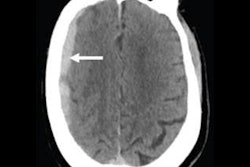
More than half of all patients who faint still undergo head CT despite a diagnostic yield of less than 3% for the exam, according to an article published in the May issue of Academic Emergency Medicine. Researchers from Canada say it's high time to cut back on using the test for most patients.
Syncope, more commonly referred to as fainting, is a temporary loss of consciousness that is associated with a low incidence of serious underlying intracranial conditions, such as hemorrhage and space-occupying lesions. As such, the vast majority of guidelines in the U.S. and Canada recommend against ordering head CT for low-risk patients with syncope who do not also present with a head injury or neurological findings.
Nevertheless, various groups have estimated that as much as two-thirds of these patients continue to receive head CT as part of their workup, noted a team led by Dr. Venkatesh Thiruganasambandamoorthy from the Ottawa Hospital Research Institute.
To determine precise head CT utilization rates for this cohort, the group searched for all studies available in the Medline, Embase, and Cochrane bibliographic databases that examined adult patients with syncope who underwent head CT. They identified 17 studies published before June 2017 that met their criteria (Acad Emerg Med, May 2019, Vol. 26:5, pp. 479-490).
Among a combined 3,361 patients with syncope in these studies, the researchers found that 1,821 (54.2%) underwent a head CT scan, yet only 2.9% of these scans turned out positive for a serious intracranial condition.
The team further categorized the data based on whether the patients presented to the emergency department or were hospitalized and found that the diagnostic yield remained low for either patient group. To be specific, the studies reported an average of only one positive finding for every 26 CT scans in the emergency department, or one in 83 scans among hospitalized patients.
| Trends in head CT utilization for patients with syncope | ||
| Emergency patients | Hospitalized patients | |
| Head CT usage rate | 54.4% | 44.8% |
| Proportion of patients with a serious intracranial condition | 3.8% | 1.2% |
The researchers also identified several risk factors that demonstrated some degree of association with serious intracranial conditions: abnormal neurologic findings, an age of at least 65 years, head trauma, use of the blood thinner warfarin, and a history of seizure or stroke. However, the team noted no shared set of characteristics for identifying patients with intracranial conditions.
"The findings of this study are consistent with the 2017 [American College of Cardiology/American Heart Association] Syncope Guideline Recommendations: CT of the head is not recommended in the routine evaluation of patients with syncope in the absence of focal neurological findings or head injury that support further evaluation," Dr. Benjamin Sun of the Perelman School of Medicine at the University of Pennsylvania said in response to the study.
Clinicians should exercise caution when ordering head CT to evaluate patients with syncope, the researchers added.
"Injudicious use of head CT to investigate syncope is not only costly but also exposes patients to high levels of radiation," they wrote. "It is therefore imperative to establish a robust set of guidelines that aids in the identification of patients that are likely to be at high risk for a serious intracranial condition."



















